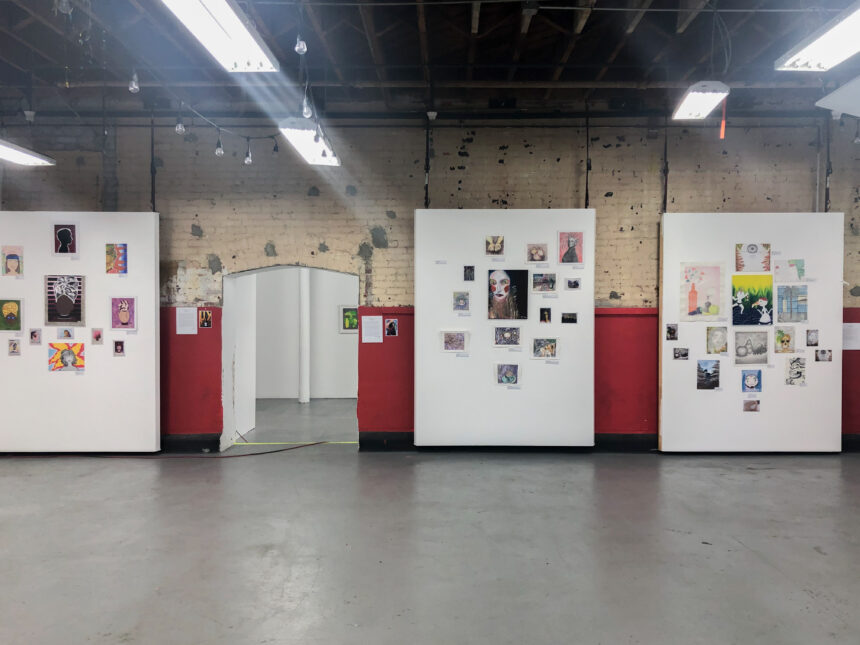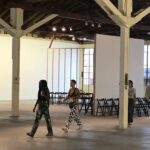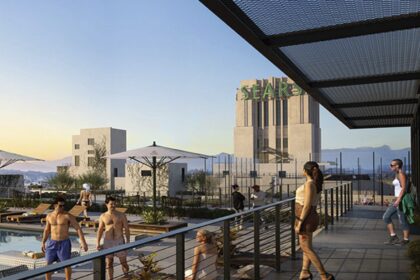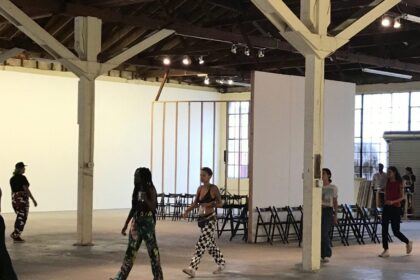Conversation with Betty Avila, Executive Director and Jennifer Cuevas, Communications Consultant at Self Help Graphics
July 2019
Betty Avila and Jennifer Cuevas discuss the history of Self Help Graphics, a small but long-standing arts non-profit in East Los Angeles. Serving as a print-making studio, an exhibition space, and a community center for almost half of a century, Self Help is a cornerstone of the Chicanx art movement in Los Angeles. It engages the community through weekly programming and annual events, including a month of Día De Los Muertos festivities and holiday mercaditos. In 2008, the building that Self Help leased on East Cesar Chavez Avenue was sold to an investment company. Faced with exponential monthly rent increases, Self Help was ultimately displaced from its home for more than thirty years. In 2011, Self Help relocated to a former seafood packing plant on 1st Street in Boyle Heights, a few blocks east of the Los Angeles River. On the day of our visit, an artist-curated exhibition, “Utopia/ Dystopia,” was mounted in the gallery at the back of the space, while movable partitions created a second gallery for the one-night exhibition, “Visual Images of Life,” by the AP studio art class from Felicitas and Gonzalo Mendez High School.

Erika Barbosa: So, Self Help Graphics has existed in East Los Angeles for forty-six years? And I think that there were earlier iterations that date even farther back. I was first introduced to Self Help through the Latinx artist and Asco member Gronk Nicandro, who my mother used to work for right around the time you relocated. I’m paraphrasing from a long time ago, but I remember he spoke of growing up with Self Help. It impressed upon me how this organization was an important community resource with a rich history of supporting homegrown artists and aesthetics.
Betty Avila: I always like to give context for the beginnings of Self Help; it explains a lot about who we are and how we came to be – and it’s important for people who are not of this community to understand that – so, whenever I walk people through [the space], I give the background of the 1960s. You have the East L.A. interchange plow through this neighborhood and almost completely encapsulate Boyle Heights in freeways, so you have a displacement that happened there, around the same time as the mass displacement of the people of Chavez Ravine. Different neighborhood, but very much a similar demographic. You have the 1968 walk-outs, the student movement that happened, that artists like Gronk would have been part of or aware of, certainly his fellow member of Asco Harry Gamboa [Jr] was part of that. In 1970, the Chicano Moratorium, which was a peaceful rally against the Vietnam war, happened, [and] ended in violence; in the murder of Rubén Salazar. And, that is all around the same time that Sister Karen, who is coming out of Immaculate Heart with Sister Corita Kent, finds herself in East L.A., connects with these other artists – Mexican and Chicano – and I think she understood from her own sort of spiritual and faith-based perspective the need for a place of healing and a place of creating. And so came Self Help Graphics, first in a garage and then eventually in a building, through a church grant.
So, as far as our roots, I think it’s always been out of a place of need. It’s almost like we couldn’t not have existed or come into being. We’ll talk to people who haven’t been back in years but who have such a deep connection to the organization, very fond memories. Then you have the people who keep coming back, and they bring their kids. There’s a multi-generational connection in this organization.
There was a lot of fear for people when the organization was forced to move. Because there was a deep connection to that [first] physical space – you have this gorgeous mosaic tile building, you have a parking lot, and for a lot of people that connection was very tied to place. And so, when we moved here I think [we understood?] understanding that there was going to be a time of adjustment. Now, fast forward many years later, I think it’s really great to understand that it’s not about a physical building as much as it is about the programming that Self Help brings, and the suture of the open door.
EB: When did you move to this location on 1st Street?
BA: The lease agreement was signed in late 2010 and we moved in in 2011.
EB: Did that adjustment period change the way that people engaged with the space at all?
BA: I think it just put some folks in a position to not be able to walk across the street to Self Help – we were previously located in a very residential part of unincorporated East L.A., so there’s people that grew up around the building, whereas here we are in a more commercially zoned area, light industrially zoned. So that was a shift. But I think it’s kind of great, we’re also now directly across the street from a high school [Mendez High School], so we have hundreds of youth who are sort of a captive audience that we can tap into and start to bring over this way. The other thing, in terms of the building, is you’re in a space that is a former fish packing plant; it doesn’t have the same amenities that the other building did. We don’t have the built-in stage, or the salon the way that the other building did, which actually was a really critical part of why some people came to Self Help: the Punk scene, the Ska scene is what brought people here. So, we’ve continued that in some ways, but we’re just working around a different space now.
EB: How are artists making use of the unique qualities of this new space? And maybe an extension of that is to ask how artists are dealing with gentrification and displacement, and does that feed into what goes on in the Self Help Graphics community space?
BA: This was before my time, but I know that when Self Help first moved here there was already an understanding of Self Help’s footprint having an impact. There were conversations that started early on when the organization first moved here, with artists. A group called R.A.I.C.E.S., Residents and Artists Investing in Community Development and Empowerment Strategies, were already starting to have these conversations – what are the implications of Self Help moving, and then generally what are the implications of development in the city and this neighborhood for artists? And so, fast forward a few years and Self Help actually worked with Inclusive Action for the City on essentially a white paper that was all about [this]: what are more equitable practices in development when you’re looking at places with these really amazing cultural assets? So, fast forward a couple years later and we want to have this conversation, specifically about how development in the neighborhood is impacting the artists, because they’re artists, but they’re also mostly People of Color; they’re also single parents, or working artists, who don’t necessarily have a degree, or maybe didn’t finish high school. So there’s a lot of overlap with non-artist populations here in the neighborhood.
And we also wanted to clarify who is actually working in this area, who’s actually developing? We were hearing a lot of, “it’s all Metro, Metro is to blame.” We wanted to clarify, as an organization in the neighborhood that is a bit more informed, who these players are, because there’s always many. That dialogue was a continuation of many years of having these conversations. Even prior to that, I think there had been community discussions around this notion of an arts corridor on 1st Street; having Self Help here on one end and Casa 0101 on the other, just on the other side of the [Interstate] 5. I think for the people who wanted to see that happen, they felt a sense of pride in the community and a sense of pride in these cultural assets. But then there were other people who understood what that could mean and what other types of development that could bring in and encourage – and then what happens to those original artists and creative businesses? So, I think that’s always the tension that exists, and understandably so. It’s the lack of equity that we see in development.
EB: When was this meeting?
BA: This last meeting was in 2016.
EB: Has there been follow up since?
BA: No, that was the meeting where that protest happened, and so we decided not to move forward on any conversations.
EB: Maybe we could talk a little bit about that protest. So much has happened since Field started research for this project. Many galleries have closed since we began interviewing folks. Last Winter, Noni Brynjolson and I attended a Defend Boyle Heights (DBH) public meeting held outside at El Pueblo de Los Ángeles Historical Monument. The organizers presented information on some of the major developers in the area and that was where I first heard them talk about the boycott. Whereas boycotting the new galleries seemed unanimous, the organizers were candid about how contentious it was for the community to hear that DBH would include Self Help Graphics in that.
BA: The meeting had a very particular goal, and we had a lot of artists who were here who wanted to be a part of that conversation, But, I think just the nature of the topic brought out a lot of other types of folks, so we had folks from foundations, and a staffer from the LA Times – I think it was just – this is an issue that’s impacting so many people and here’s an opportunity to talk about it. When that intervention happened [members of Defend Boyle Heights entered the meeting and staged an intervention], we agreed that we would pass the mic. I think for us what was really hard to hear was a really pressured group of community members, who are facing eviction, who were not able to pay rent any higher than they currently are, who are really worried and feel attacked and it’s a terrible place to be, and I say that also from the position of a lot of the staff at Self Help who are not able to live in the communities that they grew up in or are experiencing challenges for the same reason. It was tough, and especially when you have these incredible legacy artists who raised their children here at Self Help, they’re all adults now. One [artist] in particular, she has grandchildren, this is now an artist who calls herself an artist because of Self Help Graphics, and who’s now been nationally recognized, and so I think for her, now being in her 80s, to experience this moment of people from her community saying, “we don’t want your art, get out, we don’t want your art, we want jobs for our kids,” it was definitely… it just became a moment of reflection for us. We will always acknowledge that this is an issue, having been displaced from our previous location ourselves. It was just a moment to look back, to reflect, understand as an arts organization, what can we do? We’re not going to shift our mission entirely to become a community development organization, but how, within our means, can we take our creative resources and support the community?
I think in a lot of ways, that was the first big public protest that happened, and the fact that it happened here, I don’t know, I took it almost as like a, “you are of this community, please help us,” calling us out in a way [that] I think that we would disagree with tactically, but also understanding the place that they were coming from. It was actually good for us to look back, as we thought about how we move forward, and the very limited resources that we have – we’re a four-person staff now, at the time we were three. So, we really wanted to focus on advocacy, on policy-based work, thinking a little bit more long term. Obviously, the act of protesting is incredibly important and it brought so much attention to the issue, which is important, but for us it was hard too – we can’t put our resources in that. We’re going to put our resources in these broader coalitions that are working at the County Board of Supervisor level, that are working at City Council level, to try to get these long-term policy shifts, which is not as exciting, it’s not like visceral work, it’s not like being part of a protest where it feels like you’re part of this movement.
Jennifer Cuevas: It’s more of a marathon.
BA: It really is, it’s the advocacy component of it. I think that’s where the biggest shift happened. Again, the organization wasn’t going to shift its mission. Its values and its mission were very much still connected to art, the arts and art practice. However, one of the things that was part of this discovery and this reflection was the need to be at the table with these advocacy groups, to join the conversation, to bring that artistic perspective in a way that was more equitable, that was more inclusive, in a way that is holding a number of different community groups accountable at the same time. It was at that point where that pivot happened with the organization, we had already been a part of some of these coalitions, but we hadn’t previously really publicized it.
JC: Yeah, we weren’t doing a good job of sharing that part of our work.
BA: Yeah, so that pivot happened to Jenn’s credit. She really helped us do that. One of the coalitions that we’re a part of, Eastside L.E.A.D.S (Leadership for Equitable and Accountable Development Strategies), that’s a cross-sector coalition, so you have the housing organization, you have the youth focused organizations, and that’s gone beyond just Boyle Heights, it’s looking at Lincoln Heights and unincorporated East LA, City Terrace, knowing that this issue is not siloed at all. And now we’re in conversation with what’s happening in South LA, just being connected and aware. I like to bring up that there is a sense of a microcosm here in Boyle Heights, but this is happening in every major city and so it goes back to [the question], “what is the systemic change that has to happen?,” and not just the hyper focused tactics that we see here in Boyle Heights.
EB: It’s true. With these conversations around a specific neighborhood, sometimes we lose sight that it’s happening everywhere. Gentrification has already completely changed the face of so many Los Angeles neighborhoods like Echo Park and Silver Lake. The constantly inflating Arts District and the demolition and re-design of the 6th Street bridge in 2016, a bridge which connects the Arts District to Boyle Heights.
I wanted to talk a little bit about this notion of art-washing as a component of gentrification.
BA: You know, I would say we haven’t addressed that so directly because I think it’s totally, I don’t want to say unrelated to our work, but I don’t think that our work comes into question as art washing.
JC: If you look at the content that’s being created here, even from the printmaking perspective. Or, that this is a marginal space that welcomes other community groups. For example, there were nearly one thousand people here for the Women’s March, making posters and talking about issues. During the March for Our Lives this was a space of activation for a lot of the advocacy happening, and a lot of that messaging was born here. And so a lot of the creativity that’s happened here is through the struggle, so you can’t paint with the same brush, you know?
If you look at the history of Self Help, it has always been rooted in social justice. And, even though tactically, for example, we don’t agree necessarily how the group came in and protested on the day of that conversation, but as we’ve discussed, the role of an agitator is very important in our democracy and so how do we take that energy, and take that message loud and clear, and also be accountable to our community? We heard our community.
This space continues to be a low-cost to no-cost center for artists to be able to be autonomous and be able to create, and a space for other groups, whether you’re a non-profit officially recognized or collectives, [you] can come in here and create activation spaces around topics that are important right now – a lot of youth transgender, non-binary advocacy, and anti-displacement work, there’s lots of things that are happening here. This is a safe haven for a lot of different communities.
EB:It seems very important to have community arts organizations that are in resistance to this aspect of gentrification, that comes in the form of “beautification” or “revitalization.” If you have this issue of international art markets coming into the neighborhood, and you have a place like Self Help Graphics that is for the community to create art, how do those art practices come into contact with one another if at all? Has there been any dialogue between Self Help and the galleries on Anderson and Mission Rd?
BA: Not really. And, I mean, I think that’s ok. Given that we are a mission-based organization, we’re here to serve this local community. There hasn’t been much interest from those galleries to interact with us, although I know that one of the galleries was interested in opening up programming like ours and came to observe programming here at Self Help in order to then go and do something similar in their space, which you could see as potentially appropriating. But there hasn’t been anything really beyond that.
JC: Anybody that delves just a little bit into the space here will see that there is a large distinction between a national gallery that’s commercially funded, that potentially shows work of artists who are nowhere near here, that parachute in, to the work that’s being shown here, that’s uplifted here. The type of narratives that happen in this space; it’s very different. It’s like we’re two totally different beasts in a way. I think Self Help just got thrown under that broad bus, but it’s a very different kind of space here. We heard the community loud and clear: Housing is a human right. It is one of the most basic tenets that we can have – food and housing – and so what is our role in this? There is [now] a part-time staff person that’s dedicated to this advocacy, for example, who’s there at these meetings. I’ve engaged in these [meetings] as well. Betty is a part of these conversations and meetings with leadership and advocacy coalitions. We’ve literally put our money where our mouths are at this point. There is somebody dedicated to being present and making sure that Self Help is at the table for these conversations.
EB: It’s exciting to see what will come of this.
JC: One of which is a Youth Committee that’s just started. We’re recruiting for that right now. That has been one of the outcomes of the coalition building.
EB: Where are you looking at recruiting?
JC: Definitely Mendez. We’re open to young people from anywhere, but focus as much as possible here locally. We actually already have a group of young people that are teaching artists for us and are part of our studio program, so there’s going to be a little overlap. But the idea is that this youth committee would help us, much like we have an artist roundtable. It helps us sort of shape and guide the creative programming that’s available for artists. They would do the same as youth, and be that connection and reference point for us to understand what they’re doing, what’s important to them, what they want to address.
EB: That’s fantastic. I mean, they are the experts in their needs.
BA: Yeah, exactly. So speaking to that on a broader base, one of the coalitions that we’re a part of is called Invest In Youth, and that’s all about getting the City to create a Youth Development Department with the idea that currently the City is investing a lot of money in areas that are sort of, according to them, “for youth,” but a lot of that money lives under a GRYD or under LAPD, so there’s nothing where it’s actually proactive in supporting youth development. It’s all been about prevention and addressing the perceived “problem youth.”
EB: I wanted to talk a little about the Barrio Mobile Studio, which was an early project for Self Help Graphics, and recently relaunched?
BA: It is one of the original programs of Self Help, and an interesting historical piece when you look at all of the mobile programs that exist today, not just in LA but across the country. To have this group of artists who don’t have a lot of resources outfit a former delivery truck into this outdoor classroom situation, I think is super cool. Have you seen photos of it? [Yeah, it’s really cool] It’s like an old UPS-looking truck and the artwork on the outside, you know immediately the artists, and these shelves and cabinets that open up, I think that was such a novel idea but also so rooted in the artistic practice of those artists. [It’s] this notion of, “okay, we’re going to come to you. We have this space over here, but we’re going to find you in your school or your public park or what-have-you.” And one of the initial motivations for that was Day of the Dead; was using the Barrio Mobile as a literal vehicle of outreach to bring people to this big celebration and to teach people about it. Eventually, the program was sunset due to lack of funds, and then we brought it back in 2014. Since then we had an original cohort of about 25 teaching artists, and we’ve just retrained another cohort of 25 with some of the original crew, and that now includes young people that are coming out of our youth program, so they’re stepping into a paid teaching artist role. I think that sort of pipeline is important to us, because not every artist is going to want to become somebody who shows in a museum. But I think there’s a lot of interest in some of the young artists we work with to be able to facilitate creative experiences for their peers.
JC: It’s intergenerational, which is a really important tenet here. There’s a lot of skill sharing that happens, whether you’re a burgeoning artist or a very seasoned artist, that’s a really beautiful thing too, because you really get to learn. Just being in conversation with people you get to learn about the history. It’s nice to hear anecdotes from people, stuff that happened over the years, it just sparks a lot of bonding that happens between the different artists regardless of where they’re at in their careers.
EB: I love that there is this intergenerational component of the work that happens here. Are there any other initiatives or programs that you wanted to talk about?
BA: This is going to be our 46th annual Day of the Dead, and then we’ll have a full series of workshops and programs leading up to it in the month of October. We’ll have artist Melanie Cervantes, who’s going to make the commemorative print for us. She’s from Southern California, but she’s now based in the Bay. For artists who are part of the broader Self Help ecology, to be invited to participate in that capacity is really quite an honor, and she’s really an amazing artist, very social justice focused. We’re also already having conversations about what the 50th anniversary is going to look like, that will be 2023. It would be amazing if we were at that point in a position where we’d been able to renovate the building, [and] it’s at the quality and caliber we want it to be for our community, and also be able to say that we outright own the building.
JC: I think it’s also really symbolic to have that stake in this community, especially at this time, especially having been displaced, to come out really strong and stronger, now we’ve got this larger coalition building and youth being engaged even more – it’s a really wonderful time at Self Help Graphics.
Betty Avila is from Los Angeles and raised in Cypress Park. Her work has centered on the intersection of the arts and social justice, with a particular focus on community building, public space, and youth empowerment. She has held positions with the Getty Research Institute, The Music Center and the Levitt Pavilion MacArthur Park. Avila joined Self Help Graphics & Art’s leadership in 2015, an organization with a 46-year nationally-recognized artistic legacy of empowering the Chicana/o and Latinx communities of Los Angeles through the arts. She sits on the boards of the Center for Cultural Innovation, Arts for LA, and is a founding board member of People for Mobility Justice (formerly Multicultural Communities for Mobility), an organization that supports low-income communities of color that bike, walk and use public transit in Los Angeles County. Betty sat on the inaugural Advisory Committee for Los Angeles County’s Cultural Equity and Inclusion Initiative that resulted in the recommendation of cultural policy unanimously approved by the County Board of Supervisors. In 2017, Betty was named one of C-Suite Quarterly Magazine’s NextGen 10 in Philanthropy, Arts and Culture and an Impact-Maker to Watch by City Impact Labs. She received her B.A. in Literature at Pitzer College, has an M.A. in Arts Management from Claremont Graduate University, and is a 2008 Fulbright Fellow to Korea.











